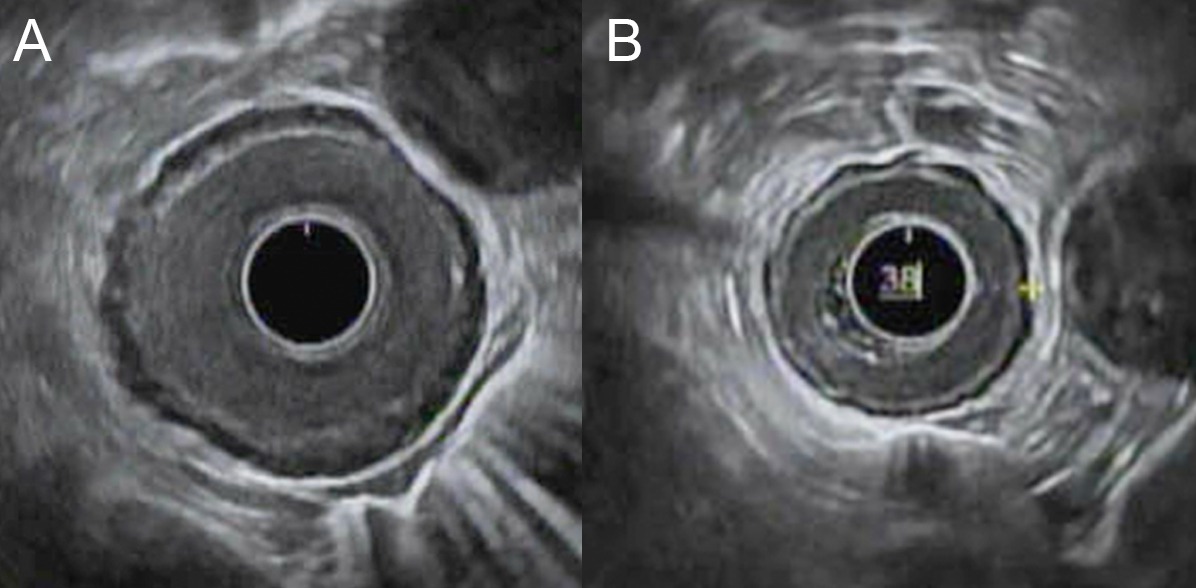Back
Tuesday Poster Session
Category: Esophagus
P3306 - An Unusual Case of Esophageal Thickening
Tuesday, October 24, 2023
10:30 AM – 4:00 PM PT
Location: Exhibit Hall
.jpg)
Nishant Aggarwal, MD (he/him/his)
William Beaumont Hospital-Royal Oak
Royal Oak, MI
Presenting Author(s)
Nishant Aggarwal, MD, Michael E.. Cannon, MD
William Beaumont Hospital-Royal Oak, Royal Oak, MI
Introduction: Eosinophilic esophagitis (EoE) is characterized by clinical features of esophageal dysfunction and pathological features of eosinophilic inflammation. We present a case of a gentleman with dysphagia who was diagnosed to have EoE based on submucosal eosinophilic infiltrate and evidence of esophageal thickening on imaging.
Case Description/Methods: A 52-year-old man with long-standing GERD and allergic rhinitis presented with new-onset dysphagia and epigastric pain for the past several weeks. His home medications included omeprazole and cetirizine. Lab work revealed peripheral eosinophilia (2.1x109/L). The esophageal mucosa appeared unremarkable on EGD except for concern for mild extrinsic esophageal stenosis. Subsequent CT scan showed circumferential thickening throughout the length of esophagus concerning for neoplasm. He then underwent an endoscopic ultrasound (EUS) which showed diffuse circumferential thickening with esophageal total wall thickness (TWT) 10 mm, primarily due to thickening of layers 2 and 3 (deep mucosa and submucosa) (figure 1A). Deep bite-on-bite biopsies revealed marked eosinophilic infiltrate in the submucosa (30 eosinophils per high power field [HPF]) but not in the mucosal layer (2/ HPF). The patient was started on prednisone taper which was later switched to swallowed fluticasone. Excellent symptomatic relief was obtained with follow-up EUS four months later showing improvement in TWT (6 mm, figure 1B) and resolution of peripheral eosinophilia (0.2 x 109/L). He is now on dupilumab with complete resolution of his symptoms.
Discussion: EoE is typically diagnosed on the basis of histopathology showing ≥15 eosinophils/HPF. Endoscopic findings consist of loss of normal mucosal vascular pattern, stacked concentric rings, strictures and linear furrows, although patients may have a normal endoscopic appearance. There have been rare reports of primary submucosal involvement,1 as seen in our patient. Treatment options include elimination diets, PPI, topical glucocorticoids, and dupilumab, which was recently approved by the FDA.
References:
1. Aswakul P, Janyangdikul P, Prachayakul V. Thickened esophagus as an unusual manifestation of eosinophilic esophagitis. Diseases of the Esophagus 2016;29:681-683.

Disclosures:
Nishant Aggarwal, MD, Michael E.. Cannon, MD. P3306 - An Unusual Case of Esophageal Thickening, ACG 2023 Annual Scientific Meeting Abstracts. Vancouver, BC, Canada: American College of Gastroenterology.
William Beaumont Hospital-Royal Oak, Royal Oak, MI
Introduction: Eosinophilic esophagitis (EoE) is characterized by clinical features of esophageal dysfunction and pathological features of eosinophilic inflammation. We present a case of a gentleman with dysphagia who was diagnosed to have EoE based on submucosal eosinophilic infiltrate and evidence of esophageal thickening on imaging.
Case Description/Methods: A 52-year-old man with long-standing GERD and allergic rhinitis presented with new-onset dysphagia and epigastric pain for the past several weeks. His home medications included omeprazole and cetirizine. Lab work revealed peripheral eosinophilia (2.1x109/L). The esophageal mucosa appeared unremarkable on EGD except for concern for mild extrinsic esophageal stenosis. Subsequent CT scan showed circumferential thickening throughout the length of esophagus concerning for neoplasm. He then underwent an endoscopic ultrasound (EUS) which showed diffuse circumferential thickening with esophageal total wall thickness (TWT) 10 mm, primarily due to thickening of layers 2 and 3 (deep mucosa and submucosa) (figure 1A). Deep bite-on-bite biopsies revealed marked eosinophilic infiltrate in the submucosa (30 eosinophils per high power field [HPF]) but not in the mucosal layer (2/ HPF). The patient was started on prednisone taper which was later switched to swallowed fluticasone. Excellent symptomatic relief was obtained with follow-up EUS four months later showing improvement in TWT (6 mm, figure 1B) and resolution of peripheral eosinophilia (0.2 x 109/L). He is now on dupilumab with complete resolution of his symptoms.
Discussion: EoE is typically diagnosed on the basis of histopathology showing ≥15 eosinophils/HPF. Endoscopic findings consist of loss of normal mucosal vascular pattern, stacked concentric rings, strictures and linear furrows, although patients may have a normal endoscopic appearance. There have been rare reports of primary submucosal involvement,1 as seen in our patient. Treatment options include elimination diets, PPI, topical glucocorticoids, and dupilumab, which was recently approved by the FDA.
References:
1. Aswakul P, Janyangdikul P, Prachayakul V. Thickened esophagus as an unusual manifestation of eosinophilic esophagitis. Diseases of the Esophagus 2016;29:681-683.

Figure: Figure 1: (A) At presentation, endoscopic ultrasound (EUS) from the distal esophagus showing thickened esophageal wall (10 mm), specifically layer 3 (submucosa), and (B) follow-up EUS after initiation of treatment showing improvement in esophageal wall thickness.
Disclosures:
Nishant Aggarwal indicated no relevant financial relationships.
Michael Cannon indicated no relevant financial relationships.
Nishant Aggarwal, MD, Michael E.. Cannon, MD. P3306 - An Unusual Case of Esophageal Thickening, ACG 2023 Annual Scientific Meeting Abstracts. Vancouver, BC, Canada: American College of Gastroenterology.
